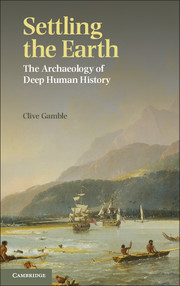Book contents
- Frontmatter
- Dedication
- Contents
- List of boxes
- List of figures
- List of tables
- Acknowledgements
- Glossary
- Web resources for skulls and stone tools
- 1 The worlds of deep human history
- 2 The drivers of climate and environment: Terrae 0–2, 10Ma–50ka
- 3 The recent veneers of climate, environment and population: Terrae 3–5, 50ka to the present day
- 4 Walking and running down the tectonic trail: Terra 0, 10–3.3Ma, and Terra 1, 3.3–1.8Ma
- 5 Three strides across a bio-tidal world: Terra 2, 1.8Ma–50ka
- 6 Going beyond, keeping in touch: Terra 3, 50–4ka
- 7 The call of the north: Terra 3, 50–4ka
- 8 Eyes on the horizon: Terra 4, 4–1ka
- 9 The human reunion in retrospect: Terra 5, after 1400 AD
- Bibliography
- Index
1 - The worlds of deep human history
Published online by Cambridge University Press: 05 June 2014
- Frontmatter
- Dedication
- Contents
- List of boxes
- List of figures
- List of tables
- Acknowledgements
- Glossary
- Web resources for skulls and stone tools
- 1 The worlds of deep human history
- 2 The drivers of climate and environment: Terrae 0–2, 10Ma–50ka
- 3 The recent veneers of climate, environment and population: Terrae 3–5, 50ka to the present day
- 4 Walking and running down the tectonic trail: Terra 0, 10–3.3Ma, and Terra 1, 3.3–1.8Ma
- 5 Three strides across a bio-tidal world: Terra 2, 1.8Ma–50ka
- 6 Going beyond, keeping in touch: Terra 3, 50–4ka
- 7 The call of the north: Terra 3, 50–4ka
- 8 Eyes on the horizon: Terra 4, 4–1ka
- 9 The human reunion in retrospect: Terra 5, after 1400 AD
- Bibliography
- Index
Summary
Going up that river was like travelling back to the earliest beginnings of the world.
Joseph Conrad, Heart of Darkness, 1902Humans Reunited
The prospect of gold had brought them into the mountains. They were pioneers in an unexplored land, and at the end of a day’s steep climb, a large fertile valley lay before them. That night the well-armed party of seventeen men grew apprehensive as they saw fires in the far distance. The next day, they met many people who carried stone axes.
This story of encounter could have happened anytime and in many places during the last 600 years. The prospectors could have been Portuguese adventurers, Spanish soldiers, English sailors, Dutch spice-merchants, French trappers, Russian whalers, Danish fishermen, Argentine ranchers or Brazilian loggers. But this was 1930 in the Bismarck ranges of Papua New Guinea (Connolly and Anderson 1988). The two Australian prospectors and their fifteen New Guinean carriers had an official permit to be there. Moreover, they expected to make contact with new people. To help their safe passage, they had brought supplies of trade axes and glass beads. What their leader, Mick Leahy, had not expected were the numbers of people living in the mountains of New Guinea. His small patrol had stumbled across more than a million Highlanders.
- Type
- Chapter
- Information
- Settling the EarthThe Archaeology of Deep Human History, pp. 1 - 31Publisher: Cambridge University PressPrint publication year: 2013



